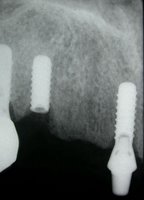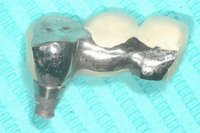Dental Implant Fracture: a complication of treatment with dental implants
 Dental implants are a functional and esthetic solution to partial and total edentulism. The initial success rate of this treatment modality is 90-95%. But, that treatment modality is not free of complications. One of the rare complications yet, with severe clinical results is fracture of dental implants. The current literature review (Biomaterials. 2002 Jun;23(12):2459-65)presents the various causative factors that may lead to implant fracture. Implant failures may be sorted into groups by the timing of their appearance, or by the origin of failure. Fractures belong to the group of late complications, caused by a biomechanical overload.
Dental implants are a functional and esthetic solution to partial and total edentulism. The initial success rate of this treatment modality is 90-95%. But, that treatment modality is not free of complications. One of the rare complications yet, with severe clinical results is fracture of dental implants. The current literature review (Biomaterials. 2002 Jun;23(12):2459-65)presents the various causative factors that may lead to implant fracture. Implant failures may be sorted into groups by the timing of their appearance, or by the origin of failure. Fractures belong to the group of late complications, caused by a biomechanical overload.  Overload may be caused by inappropriate seat of the superstructure, in-line arrangement of the implants, leverage, heavy occlusal forces (bruxing, clenching), location of the implant and the size of the implant or metal fatigue. Good clinical examinations and correct treatment plans may reduce the risk of implant fracture.
Overload may be caused by inappropriate seat of the superstructure, in-line arrangement of the implants, leverage, heavy occlusal forces (bruxing, clenching), location of the implant and the size of the implant or metal fatigue. Good clinical examinations and correct treatment plans may reduce the risk of implant fracture.*A Case Report for Fractured Implant Removal:

 >>Trephine to remove the fractured implant
>>Trephine to remove the fractured implant

 *New larger implant with bone graft into the old implant site>>
*New larger implant with bone graft into the old implant site>>
@Final Restoration:( after 6 months later from reimplantation!)
Labels: implant complications









1 Comments:
Int J Oral Maxillofac Implants. 2000 Sep-Oct;15(5):662-7.
Analysis of incidence and associated factors with fractured implants: a retrospective study.
Eckert SE, Meraw SJ, Cal E, Ow RK.
Mayo Clinic, Department of Dental Specialties, Rochester, Minnesota 55905, USA. eckert.steven@mayo.edu
Osseointegrated threaded titanium screw-type implants rarely lose integration after the first year of clinical function. Implant failure can occur for other reasons, with implant fracture being one of the major reasons for late failure. The purpose of the present study was to determine the incidence of implant fracture in completely edentulous and partially edentulous arches and to determine what factors may predispose an implant to a higher fracture risk. A retrospective evaluation of 4,937 implants was performed to determine the incidence of and factors common to fractured implants from a sample of implants placed and restored in one institutional setting. Based on the results of this study, the following observations were made: implants fracture at similar rates in the maxilla as in the mandible (0.6%), implant fractures occur more frequently in partially edentulous restorations (1.5%) than in restorations of completely edentulous arches (0.2%), all observed fractures occurred with commercially pure 3.75-mm-diameter threaded implants, and prosthetic or abutment screw loosening preceded implant fracture for the majority of the implants. More studies would be helpful to further explore the relationship and progression of factors associated with implant fracture.
Post a Comment
<< Home